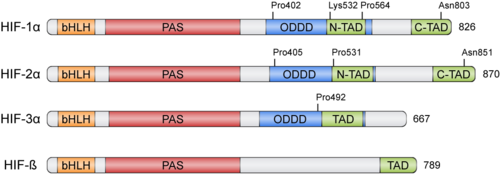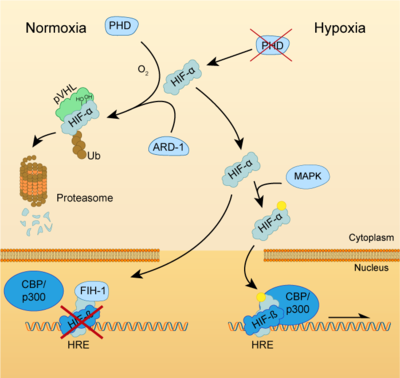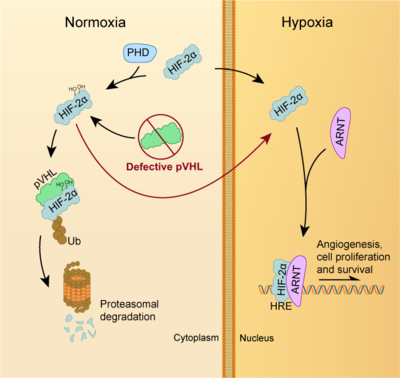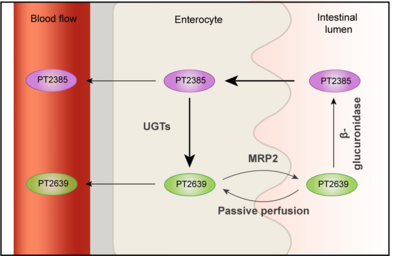Hypoxia-Inducible Factors
From Proteopedia
(Difference between revisions)
| Line 147: | Line 147: | ||
===Stroke=== | ===Stroke=== | ||
| - | Stroke is defined as a neurological deficit attributed to an acute focal injury of the CNS by a vascular case. There are two different types of strokes. The most common one is cerebral ischemia and it is due to the reduction of blood flow resulting from artery occlusion. Despite cerebral ischemia being one of the major causes of death, there is not an effective therapy yet. The central objectives for developing ischemic stroke treatments are the prevention of neuronal death and the improvement of recovery following ischemic injury<ref name="ii">PMID: 30671433</ref>. The neuroprotective effect of HIF-1α is due to the promotion of nutrient and O2 transport by the induction of proteins such as VEGF and EPO. Also, HIF-1α may prevent apoptotic cell death through the inhibition of cytochrome c release and suppression of p53. Despite the protective effects of HIF-1α, some studies have reported the contribution of HIF-1 to cellular and tissue damage by promoting pro-apoptotic pathways via p53 or necrosis<ref>PMID: 30106145</ref>. | + | Stroke is defined as a neurological deficit attributed to an acute focal injury of the CNS by a vascular case. There are two different types of strokes. The most common one is cerebral ischemia and it is due to the reduction of blood flow resulting from artery occlusion. Despite cerebral ischemia being one of the major causes of death, there is not an effective therapy yet. The central objectives for developing ischemic stroke treatments are the prevention of neuronal death and the improvement of recovery following ischemic injury<ref name="ii">PMID: 30671433</ref>. Traditional approaches have failed when translated to the clinic because of the multiple mechanisms and heterogeneous populations that are affected during stroke. in this scenario, HIF could be a potential candidate given the multiple pathways involved in its cascade. The neuroprotective effect of HIF-1α is due to the promotion of nutrient and O2 transport by the induction of proteins such as VEGF and EPO. Also, HIF-1α may prevent apoptotic cell death through the inhibition of cytochrome c release and suppression of p53. Despite the protective effects of HIF-1α, some studies have reported the contribution of HIF-1 to cellular and tissue damage by promoting pro-apoptotic pathways via p53 or necrosis<ref>PMID: 30106145</ref>. |
| - | Another major obstacle to develop treatments is that HIF-1α mRNA and protein levels have a biphasic expression pattern following ischemic injury. At early stages, HIF-1α activates pro-apoptotic pathways while at later stages boosts cell survival pathways. This | + | Another major obstacle to develop treatments is that HIF-1α mRNA and protein levels have a biphasic expression pattern following ischemic injury. At early stages, HIF-1α upregulation activates pro-apoptotic pathways while at later stages boosts cell survival pathways. This equilibrium is really important in the administration of HIF-1α activating drugs to avoid increasing tissue damage instead of enhancing recovery <ref>PMID: 26030758</ref><ref name="ii"/>. |
| - | Even with the controversy of the neuroprotective effect of HIF-1, beneficial characteristics appear to outweigh adverse effects. For this reason, use of HIF-1 activators can improve the evolution of cerebral ischemia patients <ref name="Cornell">''Cerebral Ischemia'', Weill Cornell Brain and Spine Center [https://weillcornellbrainandspine.org/condition/ischemia-cerebral]</ref>. | + | Even with the controversy of the neuroprotective effect of HIF-1, beneficial characteristics appear to outweigh adverse effects. For this reason, use of HIF-1 activators can improve the evolution of cerebral ischemia patients <ref name="Cornell">''Cerebral Ischemia'', Weill Cornell Brain and Spine Center [https://weillcornellbrainandspine.org/condition/ischemia-cerebral https://weillcornellbrainandspine.org/condition/ischemia-cerebral]</ref>. |
Revision as of 18:43, 26 November 2020
| |||||||||||
References
- ↑ Ke Q, Costa M. Hypoxia-inducible factor-1 (HIF-1). Mol Pharmacol. 2006 Nov;70(5):1469-80. doi: 10.1124/mol.106.027029. Epub 2006 Aug, 3. PMID:16887934 doi:http://dx.doi.org/10.1124/mol.106.027029
- ↑ Wu D, Potluri N, Lu J, Kim Y, Rastinejad F. Structural integration in hypoxia-inducible factors. Nature. 2015 Aug 5. doi: 10.1038/nature14883. PMID:26245371 doi:http://dx.doi.org/10.1038/nature14883
- ↑ Goldberg MA, Dunning SP, Bunn HF. Regulation of the erythropoietin gene: evidence that the oxygen sensor is a heme protein. Science. 1988 Dec 9;242(4884):1412-5. doi: 10.1126/science.2849206. PMID:2849206 doi:http://dx.doi.org/10.1126/science.2849206
- ↑ Semenza GL, Nejfelt MK, Chi SM, Antonarakis SE. Hypoxia-inducible nuclear factors bind to an enhancer element located 3' to the human erythropoietin gene. Proc Natl Acad Sci U S A. 1991 Jul 1;88(13):5680-4. doi: 10.1073/pnas.88.13.5680. PMID:2062846 doi:http://dx.doi.org/10.1073/pnas.88.13.5680
- ↑ Wang GL, Jiang BH, Rue EA, Semenza GL. Hypoxia-inducible factor 1 is a basic-helix-loop-helix-PAS heterodimer regulated by cellular O2 tension. Proc Natl Acad Sci U S A. 1995 Jun 6;92(12):5510-4. PMID:7539918
- ↑ Reyes H, Reisz-Porszasz S, Hankinson O. Identification of the Ah receptor nuclear translocator protein (Arnt) as a component of the DNA binding form of the Ah receptor. Science. 1992 May 22;256(5060):1193-5. PMID:1317062
- ↑ Dames SA, Martinez-Yamout M, De Guzman RN, Dyson HJ, Wright PE. Structural basis for Hif-1 alpha /CBP recognition in the cellular hypoxic response. Proc Natl Acad Sci U S A. 2002 Apr 16;99(8):5271-6. PMID:11959977 doi:http://dx.doi.org/10.1073/pnas.082121399
- ↑ Loboda A, Jozkowicz A, Dulak J. HIF-1 and HIF-2 transcription factors--similar but not identical. Mol Cells. 2010 May;29(5):435-42. doi: 10.1007/s10059-010-0067-2. Epub 2010 Apr, 12. PMID:20396958 doi:http://dx.doi.org/10.1007/s10059-010-0067-2
- ↑ Manalo DJ, Rowan A, Lavoie T, Natarajan L, Kelly BD, Ye SQ, Garcia JG, Semenza GL. Transcriptional regulation of vascular endothelial cell responses to hypoxia by HIF-1. Blood. 2005 Jan 15;105(2):659-69. doi: 10.1182/blood-2004-07-2958. Epub 2004 Sep , 16. PMID:15374877 doi:http://dx.doi.org/10.1182/blood-2004-07-2958
- ↑ Bruick RK, McKnight SL. A conserved family of prolyl-4-hydroxylases that modify HIF. Science. 2001 Nov 9;294(5545):1337-40. doi: 10.1126/science.1066373. Epub 2001, Oct 11. PMID:11598268 doi:http://dx.doi.org/10.1126/science.1066373
- ↑ Kamura T, Sato S, Iwai K, Czyzyk-Krzeska M, Conaway RC, Conaway JW. Activation of HIF1alpha ubiquitination by a reconstituted von Hippel-Lindau (VHL) tumor suppressor complex. Proc Natl Acad Sci U S A. 2000 Sep 12;97(19):10430-5. PMID:10973499 doi:http://dx.doi.org/10.1073/pnas.190332597
- ↑ Jeong JW, Bae MK, Ahn MY, Kim SH, Sohn TK, Bae MH, Yoo MA, Song EJ, Lee KJ, Kim KW. Regulation and destabilization of HIF-1alpha by ARD1-mediated acetylation. Cell. 2002 Nov 27;111(5):709-20. PMID:12464182
- ↑ Lando D, Peet DJ, Whelan DA, Gorman JJ, Whitelaw ML. Asparagine hydroxylation of the HIF transactivation domain a hypoxic switch. Science. 2002 Feb 1;295(5556):858-61. doi: 10.1126/science.1068592. PMID:11823643 doi:http://dx.doi.org/10.1126/science.1068592
- ↑ Richard DE, Berra E, Gothie E, Roux D, Pouyssegur J. p42/p44 mitogen-activated protein kinases phosphorylate hypoxia-inducible factor 1alpha (HIF-1alpha) and enhance the transcriptional activity of HIF-1. J Biol Chem. 1999 Nov 12;274(46):32631-7. doi: 10.1074/jbc.274.46.32631. PMID:10551817 doi:http://dx.doi.org/10.1074/jbc.274.46.32631
- ↑ 15.0 15.1 15.2 Davis CK, Jain SA, Bae ON, Majid A, Rajanikant GK. Hypoxia Mimetic Agents for Ischemic Stroke. Front Cell Dev Biol. 2019 Jan 8;6:175. doi: 10.3389/fcell.2018.00175. eCollection, 2018. PMID:30671433 doi:http://dx.doi.org/10.3389/fcell.2018.00175
- ↑ Zaman K, Ryu H, Hall D, O'Donovan K, Lin KI, Miller MP, Marquis JC, Baraban JM, Semenza GL, Ratan RR. Protection from oxidative stress-induced apoptosis in cortical neuronal cultures by iron chelators is associated with enhanced DNA binding of hypoxia-inducible factor-1 and ATF-1/CREB and increased expression of glycolytic enzymes, p21(waf1/cip1), and erythropoietin. J Neurosci. 1999 Nov 15;19(22):9821-30. PMID:10559391
- ↑ Demougeot C, Van Hoecke M, Bertrand N, Prigent-Tessier A, Mossiat C, Beley A, Marie C. Cytoprotective efficacy and mechanisms of the liposoluble iron chelator 2,2'-dipyridyl in the rat photothrombotic ischemic stroke model. J Pharmacol Exp Ther. 2004 Dec;311(3):1080-7. doi: 10.1124/jpet.104.072744. Epub , 2004 Jul 27. PMID:15280435 doi:http://dx.doi.org/10.1124/jpet.104.072744
- ↑ Nagel S, Papadakis M, Chen R, Hoyte LC, Brooks KJ, Gallichan D, Sibson NR, Pugh C, Buchan AM. Neuroprotection by dimethyloxalylglycine following permanent and transient focal cerebral ischemia in rats. J Cereb Blood Flow Metab. 2011 Jan;31(1):132-43. doi: 10.1038/jcbfm.2010.60. Epub, 2010 Apr 21. PMID:20407463 doi:http://dx.doi.org/10.1038/jcbfm.2010.60
- ↑ Reischl S, Li L, Walkinshaw G, Flippin LA, Marti HH, Kunze R. Inhibition of HIF prolyl-4-hydroxylases by FG-4497 reduces brain tissue injury and edema formation during ischemic stroke. PLoS One. 2014 Jan 7;9(1):e84767. doi: 10.1371/journal.pone.0084767. eCollection , 2014. PMID:24409307 doi:http://dx.doi.org/10.1371/journal.pone.0084767
- ↑ Davis CK, Nampoothiri SS, Rajanikant GK. Folic Acid Exerts Post-Ischemic Neuroprotection In Vitro Through HIF-1alpha Stabilization. Mol Neurobiol. 2018 Nov;55(11):8328-8345. doi: 10.1007/s12035-018-0982-3. Epub, 2018 Mar 14. PMID:29542054 doi:http://dx.doi.org/10.1007/s12035-018-0982-3
- ↑ Liu FJ, Kaur P, Karolina DS, Sepramaniam S, Armugam A, Wong PT, Jeyaseelan K. MiR-335 Regulates Hif-1alpha to Reduce Cell Death in Both Mouse Cell Line and Rat Ischemic Models. PLoS One. 2015 Jun 1;10(6):e0128432. doi: 10.1371/journal.pone.0128432., eCollection 2015. PMID:26030758 doi:http://dx.doi.org/10.1371/journal.pone.0128432
- ↑ Doeppner TR, Mlynarczuk-Bialy I, Kuckelkorn U, Kaltwasser B, Herz J, Hasan MR, Hermann DM, Bahr M. The novel proteasome inhibitor BSc2118 protects against cerebral ischaemia through HIF1A accumulation and enhanced angioneurogenesis. Brain. 2012 Nov;135(Pt 11):3282-97. doi: 10.1093/brain/aws269. PMID:23169919 doi:http://dx.doi.org/10.1093/brain/aws269
- ↑ Badawi Y, Shi H. Relative Contribution of Prolyl Hydroxylase-Dependent and -Independent Degradation of HIF-1alpha by Proteasomal Pathways in Cerebral Ischemia. Front Neurosci. 2017 May 17;11:239. doi: 10.3389/fnins.2017.00239. eCollection, 2017. PMID:28566998 doi:http://dx.doi.org/10.3389/fnins.2017.00239
- ↑ 24.0 24.1 Greenberger LM, Horak ID, Filpula D, Sapra P, Westergaard M, Frydenlund HF, Albaek C, Schroder H, Orum H. A RNA antagonist of hypoxia-inducible factor-1alpha, EZN-2968, inhibits tumor cell growth. Mol Cancer Ther. 2008 Nov;7(11):3598-608. doi: 10.1158/1535-7163.MCT-08-0510., Epub 2008 Oct 30. PMID:18974394 doi:http://dx.doi.org/10.1158/1535-7163.MCT-08-0510
- ↑ Patnaik A, Chiorean EG, Tolcher A, Papadopoulos K, Beeram M, Waddell DK, et al. EZN-2968, a novel hypoxia-inducible factor-1 (HIF-1) messenger ribonucleic acid (mRNA) antagonist: Results of a phase I, pharmacokinetic (PK), dose-escalation study of daily administration in patients (pts) with advanced malignancies. J Clin Oncol. 2009;27(15):2564–2564. doi: 10.1200/jco.2009.27.15_suppl.2564
- ↑ Jeong W, Rapisarda A, Park SR, Kinders RJ, Chen A, Melillo G, Turkbey B, Steinberg SM, Choyke P, Doroshow JH, Kummar S. Pilot trial of EZN-2968, an antisense oligonucleotide inhibitor of hypoxia-inducible factor-1 alpha (HIF-1alpha), in patients with refractory solid tumors. Cancer Chemother Pharmacol. 2014 Feb;73(2):343-8. doi: 10.1007/s00280-013-2362-z., Epub 2013 Nov 30. PMID:24292632 doi:http://dx.doi.org/10.1007/s00280-013-2362-z
- ↑ Rapisarda A, Uranchimeg B, Sordet O, Pommier Y, Shoemaker RH, Melillo G. Topoisomerase I-mediated inhibition of hypoxia-inducible factor 1: mechanism and therapeutic implications. Cancer Res. 2004 Feb 15;64(4):1475-82. doi: 10.1158/0008-5472.can-03-3139. PMID:14983893 doi:http://dx.doi.org/10.1158/0008-5472.can-03-3139
- ↑ Mabjeesh NJ, Escuin D, LaVallee TM, Pribluda VS, Swartz GM, Johnson MS, Willard MT, Zhong H, Simons JW, Giannakakou P. 2ME2 inhibits tumor growth and angiogenesis by disrupting microtubules and dysregulating HIF. Cancer Cell. 2003 Apr;3(4):363-75. doi: 10.1016/s1535-6108(03)00077-1. PMID:12726862 doi:http://dx.doi.org/10.1016/s1535-6108(03)00077-1
- ↑ Mabjeesh NJ, Escuin D, LaVallee TM, Pribluda VS, Swartz GM, Johnson MS, Willard MT, Zhong H, Simons JW, Giannakakou P. 2ME2 inhibits tumor growth and angiogenesis by disrupting microtubules and dysregulating HIF. Cancer Cell. 2003 Apr;3(4):363-75. doi: 10.1016/s1535-6108(03)00077-1. PMID:12726862 doi:http://dx.doi.org/10.1016/s1535-6108(03)00077-1
- ↑ Jaeger AM, Whitesell L. HSP90: Enabler of Cancer Adaptation. Annu Rev Cancer Biol. 2019;3:275–97. doi: https://doi.org/10.1146/annurev-cancerbio-030518-055533
- ↑ Turtoi A, Peixoto P, Castronovo V, Bellahcene A. Histone deacetylases and cancer-associated angiogenesis: current understanding of the biology and clinical perspectives. Crit Rev Oncog. 2015;20(1-2):119-37. doi: 10.1615/critrevoncog.2014012423. PMID:25746107 doi:http://dx.doi.org/10.1615/critrevoncog.2014012423
- ↑ Zhang C, Yang C, Feldman MJ, Wang H, Pang Y, Maggio DM, Zhu D, Nesvick CL, Dmitriev P, Bullova P, Chittiboina P, Brady RO, Pacak K, Zhuang Z. Vorinostat suppresses hypoxia signaling by modulating nuclear translocation of hypoxia inducible factor 1 alpha. Oncotarget. 2017 May 23;8(34):56110-56125. doi: 10.18632/oncotarget.18125., eCollection 2017 Aug 22. PMID:28915577 doi:http://dx.doi.org/10.18632/oncotarget.18125
- ↑ 33.0 33.1 Turtoi A, Peixoto P, Castronovo V, Bellahcene A. Histone deacetylases and cancer-associated angiogenesis: current understanding of the biology and clinical perspectives. Crit Rev Oncog. 2015;20(1-2):119-37. doi: 10.1615/critrevoncog.2014012423. PMID:25746107 doi:http://dx.doi.org/10.1615/critrevoncog.2014012423
- ↑ Lee K, Zhang H, Qian DZ, Rey S, Liu JO, Semenza GL. Acriflavine inhibits HIF-1 dimerization, tumor growth, and vascularization. Proc Natl Acad Sci U S A. 2009 Oct 20;106(42):17910-5. doi:, 10.1073/pnas.0909353106. Epub 2009 Oct 1. PMID:19805192 doi:http://dx.doi.org/10.1073/pnas.0909353106
- ↑ Mangraviti A, Raghavan T, Volpin F, Skuli N, Gullotti D, Zhou J, Asnaghi L, Sankey E, Liu A, Wang Y, Lee DH, Gorelick N, Serra R, Peters M, Schriefer D, Delaspre F, Rodriguez FJ, Eberhart CG, Brem H, Olivi A, Tyler B. HIF-1alpha- Targeting Acriflavine Provides Long Term Survival and Radiological Tumor Response in Brain Cancer Therapy. Sci Rep. 2017 Nov 2;7(1):14978. doi: 10.1038/s41598-017-14990-w. PMID:29097800 doi:http://dx.doi.org/10.1038/s41598-017-14990-w
- ↑ Zhang H, Qian DZ, Tan YS, Lee K, Gao P, Ren YR, Rey S, Hammers H, Chang D, Pili R, Dang CV, Liu JO, Semenza GL. Digoxin and other cardiac glycosides inhibit HIF-1alpha synthesis and block tumor growth. Proc Natl Acad Sci U S A. 2008 Dec 16;105(50):19579-86. doi:, 10.1073/pnas.0809763105. Epub 2008 Nov 19. PMID:19020076 doi:http://dx.doi.org/10.1073/pnas.0809763105
- ↑ Yoshida T, Zhang H, Iwase T, Shen J, Semenza GL, Campochiaro PA. Digoxin inhibits retinal ischemia-induced HIF-1alpha expression and ocular neovascularization. FASEB J. 2010 Jun;24(6):1759-67. doi: 10.1096/fj.09-145664. Epub 2010 Jan 11. PMID:20065104 doi:http://dx.doi.org/10.1096/fj.09-145664
- ↑ Reece KM, Richardson ED, Cook KM, Campbell TJ, Pisle ST, Holly AJ, Venzon DJ, Liewehr DJ, Chau CH, Price DK, Figg WD. Epidithiodiketopiperazines (ETPs) exhibit in vitro antiangiogenic and in vivo antitumor activity by disrupting the HIF-1alpha/p300 complex in a preclinical model of prostate cancer. Mol Cancer. 2014 Apr 28;13:91. doi: 10.1186/1476-4598-13-91. PMID:24775564 doi:http://dx.doi.org/10.1186/1476-4598-13-91
- ↑ Befani CD, Vlachostergios PJ, Hatzidaki E, Patrikidou A, Bonanou S, Simos G, Papandreou CN, Liakos P. Bortezomib represses HIF-1alpha protein expression and nuclear accumulation by inhibiting both PI3K/Akt/TOR and MAPK pathways in prostate cancer cells. J Mol Med (Berl). 2012 Jan;90(1):45-54. doi: 10.1007/s00109-011-0805-8. Epub 2011, Sep 10. PMID:21909688 doi:http://dx.doi.org/10.1007/s00109-011-0805-8
- ↑ 40.0 40.1 Kong D, Park EJ, Stephen AG, Calvani M, Cardellina JH, Monks A, Fisher RJ, Shoemaker RH, Melillo G. Echinomycin, a small-molecule inhibitor of hypoxia-inducible factor-1 DNA-binding activity. Cancer Res. 2005 Oct 1;65(19):9047-55. doi: 10.1158/0008-5472.CAN-05-1235. PMID:16204079 doi:http://dx.doi.org/10.1158/0008-5472.CAN-05-1235
- ↑ Hockel M, Vaupel P. Tumor hypoxia: definitions and current clinical, biologic, and molecular aspects. J Natl Cancer Inst. 2001 Feb 21;93(4):266-76. doi: 10.1093/jnci/93.4.266. PMID:11181773 doi:http://dx.doi.org/10.1093/jnci/93.4.266
- ↑ WARBURG O. On respiratory impairment in cancer cells. Science. 1956 Aug 10;124(3215):269-70. PMID:13351639
- ↑ Wallace EM, Rizzi JP, Han G, Wehn PM, Cao Z, Du X, Cheng T, Czerwinski RM, Dixon DD, Goggin BS, Grina JA, Halfmann MM, Maddie MA, Olive SR, Schlachter ST, Tan H, Wang B, Wang K, Xie S, Xu R, Yang H, Josey JA. A Small-Molecule Antagonist of HIF2alpha Is Efficacious in Preclinical Models of Renal Cell Carcinoma. Cancer Res. 2016 Sep 15;76(18):5491-500. doi: 10.1158/0008-5472.CAN-16-0473. Epub, 2016 Sep 6. PMID:27635045 doi:http://dx.doi.org/10.1158/0008-5472.CAN-16-0473
- ↑ Courtney KD, Infante JR, Lam ET, Figlin RA, Rini BI, Brugarolas J, Zojwalla NJ, Lowe AM, Wang K, Wallace EM, Josey JA, Choueiri TK. Phase I Dose-Escalation Trial of PT2385, a First-in-Class Hypoxia-Inducible Factor-2alpha Antagonist in Patients With Previously Treated Advanced Clear Cell Renal Cell Carcinoma. J Clin Oncol. 2018 Mar 20;36(9):867-874. doi: 10.1200/JCO.2017.74.2627. Epub 2017, Dec 19. PMID:29257710 doi:http://dx.doi.org/10.1200/JCO.2017.74.2627
- ↑ Xu R, Wang K, Rizzi JP, Huang H, Grina JA, Schlachter ST, Wang B, Wehn PM, Yang H, Dixon DD, Czerwinski RM, Du X, Ged EL, Han G, Tan H, Wong T, Xie S, Josey JA, Wallace EM. 3-[(1S,2S,3R)-2,3-Difluoro-1-hydroxy-7-methylsulfonylindan-4-yl]oxy-5-fluorobenzo nitrile (PT2977), a Hypoxia-Inducible Factor 2alpha (HIF-2alpha) Inhibitor for the Treatment of Clear Cell Renal Cell Carcinoma. J Med Chem. 2019 Aug 8;62(15):6876-6893. doi: 10.1021/acs.jmedchem.9b00719. Epub , 2019 Jul 8. PMID:31282155 doi:http://dx.doi.org/10.1021/acs.jmedchem.9b00719
- ↑ Xu R, Wang K, Rizzi JP, Huang H, Grina JA, Schlachter ST, Wang B, Wehn PM, Yang H, Dixon DD, Czerwinski RM, Du X, Ged EL, Han G, Tan H, Wong T, Xie S, Josey JA, Wallace EM. 3-[(1S,2S,3R)-2,3-Difluoro-1-hydroxy-7-methylsulfonylindan-4-yl]oxy-5-fluorobenzo nitrile (PT2977), a Hypoxia-Inducible Factor 2alpha (HIF-2alpha) Inhibitor for the Treatment of Clear Cell Renal Cell Carcinoma. J Med Chem. 2019 Aug 8;62(15):6876-6893. doi: 10.1021/acs.jmedchem.9b00719. Epub , 2019 Jul 8. PMID:31282155 doi:http://dx.doi.org/10.1021/acs.jmedchem.9b00719
- ↑ 47.0 47.1 Davis CK, Jain SA, Bae ON, Majid A, Rajanikant GK. Hypoxia Mimetic Agents for Ischemic Stroke. Front Cell Dev Biol. 2019 Jan 8;6:175. doi: 10.3389/fcell.2018.00175. eCollection, 2018. PMID:30671433 doi:http://dx.doi.org/10.3389/fcell.2018.00175
- ↑ Zhang Z, Yao L, Yang J, Wang Z, Du G. PI3K/Akt and HIF1 signaling pathway in hypoxiaischemia (Review). Mol Med Rep. 2018 Oct;18(4):3547-3554. doi: 10.3892/mmr.2018.9375. Epub 2018 Aug , 9. PMID:30106145 doi:http://dx.doi.org/10.3892/mmr.2018.9375
- ↑ Liu FJ, Kaur P, Karolina DS, Sepramaniam S, Armugam A, Wong PT, Jeyaseelan K. MiR-335 Regulates Hif-1alpha to Reduce Cell Death in Both Mouse Cell Line and Rat Ischemic Models. PLoS One. 2015 Jun 1;10(6):e0128432. doi: 10.1371/journal.pone.0128432., eCollection 2015. PMID:26030758 doi:http://dx.doi.org/10.1371/journal.pone.0128432
- ↑ Cerebral Ischemia, Weill Cornell Brain and Spine Center https://weillcornellbrainandspine.org/condition/ischemia-cerebral
Proteopedia Page Contributors and Editors (what is this?)
Gonzalo Garcia-Martin, Michal Harel, Carmen Paredes Yubero, Rocío Moreno





